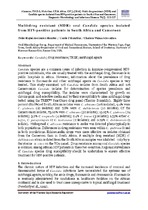| dc.contributor.author | Abrantes, Pedro Miguel dos Santos | |
| dc.contributor.author | McArthur, Carole P. | |
| dc.contributor.author | Africa, Charlene W.J. | |
| dc.date.accessioned | 2014-05-21T14:18:55Z | |
| dc.date.available | 2014-05-21T14:18:55Z | |
| dc.date.issued | 2014 | |
| dc.identifier.citation | Abrantes, P.M.D.S. McArthur, C.P. &Africa, C.W.J. (2014). Multi-drug resistant (MDR) oral Candida species isolated from HIV-positive patients in South Africa and Cameroon. Diagnostic Microbiology and Infectious Disease, 79(2): 222–227 | en_US |
| dc.identifier.issn | 0732-8893 | |
| dc.identifier.uri | http://hdl.handle.net/10566/1082 | |
| dc.description.abstract | Candida species are a common cause of infection in immune-compromised HIV-positive individuals, who are usually treated with the antifungal drug, fluconazole in public hospitals in Africa. However, information about the prevalence of drug resistance to fluconazole and other antifungal agents on Candida species is very limited. This study examined 128 Candida isolates from South Africa and 126 Cameroonian Candida isolates for determination of species prevalence and antifungal drug susceptibility. The isolates were characterized by growth on chromogenic and selective media and by their susceptibility to nine antifungal drugs tested using the TREK™ YeastOne9 drug panel (Thermo Scientific). Eighty three percent (82.8%) of South African isolates were C. albicans (106 isolates), 9.4% were C. glabrata (12 isolates) and 7.8% were C. dubliniensis (10 isolates). Of the Cameroonian isolates, 73.02% were C. albicans (92 isolates); 19.05% C. glabrata (24 isolates); 3.2% C. tropicalis (4 isolates); 2.4% C. krusei (3 isolates); 1.59% either C. kefyr, C. parapsilopsis or C. lusitaneae (2 isolates); and 0.79% C. dubliniensis (1 isolate). Widespread C. albicans resistance to azoles was detected phenotypically in both populations. Differences in drug resistance were seen within C. glabrata found in both populations. Echinocandin drugs were more effective on isolates obtained from the Cameroon than in South Africa. A multiple drug resistant (MDR) C. dubliniensis strain isolated from the South African samples was inhibited only by 5-flucytosine in vitro on the YO9 panel. Drug resistance among oral Candida species is common among African HIV patients in these two countries. Regional surveillance of Candida species drug susceptibility should be undertaken to ensure effective treatment for HIV-positive patients. | en_US |
| dc.description.sponsorship | National Research Foundation of South Africa | en_US |
| dc.language.iso | en | en_US |
| dc.publisher | Elsevier | en_US |
| dc.rights | © 2014 Elsevier. This is the authors' final version and may be freely used provided that the source is acknowledged. | |
| dc.source.uri | http://dx.doi.org/10.1016/j.diagmicrobio.2013.09.016 | |
| dc.subject | Candida | en_US |
| dc.subject | Drug resistance | en_US |
| dc.subject | TREK | en_US |
| dc.subject | Antifungal agents | en_US |
| dc.title | Multi-drug resistant (MDR) oral Candida species isolated from HIV-positive patients in South Africa and Cameroon | en_US |
| dc.type | Article | en_US |
| dc.privacy.showsubmitter | false | |
| dc.status.ispeerreviewed | true | |
| dc.description.accreditation | Web of Science | en_US |

